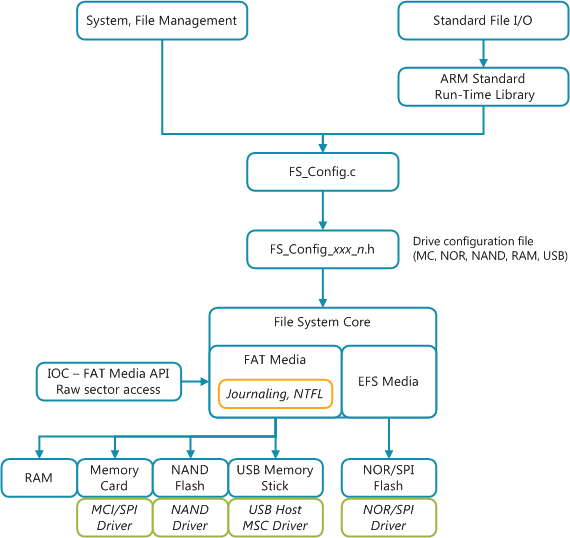 |
File System Component
Version 6.16.6
MDK Middleware for Devices with Flash File System
|
 |
File System Component
Version 6.16.6
MDK Middleware for Devices with Flash File System
|
The File System Component provides functions to create, save, read, and modify files. The Retarget Interface of the ARM C/C++ compiler run-time library allows the usage of ANSI C standard file I/O functions. The File System Component is designed for Cortex-M processor-based devices and requires an CMSIS-RTOS compliant real-time operating system for thread-safe operation.
The File System Component consists of two different file systems, placed on top of different layers, depending on the media type:
The File System Component integrates with the ARM Standard Run-Time Library and requires a CMSIS-RTOS compliant RTOS. It cannot be used with the ARM MicroLIB library since this library does not provide the hooks for I/O file handling.
The following picture shows the File System's structure from a developer's perspective.

The configuration steps and files that are needed to create applications for the different devices are explained here:
The File System Component supports various memory and storage devices that are assigned to a drive.

All available drives are defined with the RTE Component Selection. A drive is passed as string to System Routines and may be part of a filename. The system allows you to configure a current drive that is used when no drive is specified as part of the filename.
The file system type is automatically chosen depending on the drive type (which correlates to a certain memory device). Some drives may use different interfaces that will be covered by appropriate CMSIS-Drivers. The following table shows the relationship between drive - memory device - and driver/interface:
| Drive | File System | Drive Type | CMSIS-Driver/Interface |
|---|---|---|---|
| "F:" or "F0:" | EFS | NOR Flash drive 0 | (Memory Bus or |
| "F1:" | EFS | NOR Flash drive 1 | (Memory Bus or |
| "R:" or "R0:" | FAT | RAM drive | N/A |
| "M:" or "M0:" | FAT | Memory Card drive 0 | or |
| "M1:" | FAT | Memory Card drive 1 | or |
| "U:" or "U0:" | FAT | USB Memory Stick drive 0 | |
| "U1:" | FAT | USB Memory Stick drive 1 | |
| "N:" or "N0:" | FAT | NAND Flash drive 0 | (Memory Bus) |
| "N1:" | FAT | NAND Flash drive 1 | (Memory Bus) |
The Current Drive defines the drive used when the filename itself does not specify the drive or when functions that expect a drive are called with an empty ("") string.
An Initial Current Drive is defined in the FS_Config.c configuration file and is used at startup to set the Current Drive. The Current Drive can be changed during run-time using the function fchdrive.